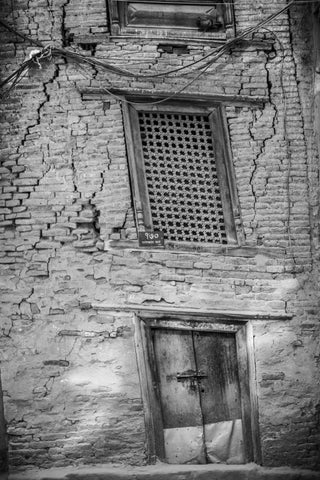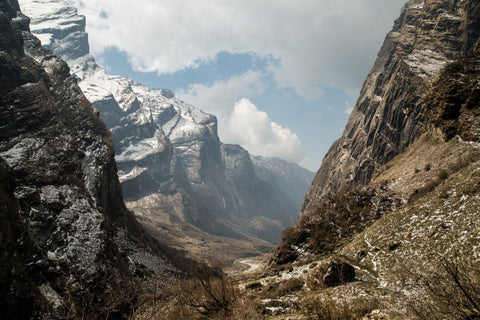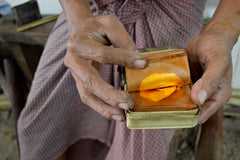by Nina Strategier |
June 01, 2016
For English scroll down
Nepal is wat rustiger dan India. Dat is precies wat we nodig hadden. Na het drukke India was Kathamandu een oase van rust (sort of dan..). Maar voor de gemiddelde Europeaan is het waarschijnlijk een wervelstorm van auto’s, geluiden, stof en mensen. De hoofdstad is deels nog steeds verwoest door de aardbeving van 2015. Overal zie je resten van ingestorte en beschadigde gebouwen.

Ook in Nepal is het eten lekker. Vooral rijst en linzen. Er zijn veel Tibetaanse restaurants en we hebben meermaals typische Tibetaanse gerechten geprobeerd zoals momo’s, deeg gevuld met groenten, kaas of buffalovlees.
De lagere delen van het land zijn extreem heet in mei. Daardoor was het soms vermoeiend om rond te lopen… Electriciteitsuitval is een groot problem in het land. Bijna elke stad heeft 8 uur durende power cuts. Als dit midden in de nacht is zweet je je kapot in bed omdat de ventilator of air-conditioner het niet doet. Een ander problem is het watertekort. Vaak moeten mensen uren in de rij staan om hun jerrycans the vullen. Ook midden in de nacht..
Om af te koelen zijn we gaan hiken. De met sneeuw bedekte bergtoppen zijn super mooi en het was sowieso een goede workout. Na 7 dagen traplopen, traplopen, nog meer trappen, een hagelstorm in de middle of nowhere en een freezing nacht in Machhapucchre basecamp waren we blij dat we weer terug konden naar Pokhara, een toeristisch stadje aan een meer, waar we weer een warme douche konden nemen.

Net als in India dragen de locals traditionele kleding. Vrouwen dragen meestal een sari, een kleurrijke lap stof die ze om zich heen wikkelen. Aan sieraden ook geen gebrek. De zilveren neusbellen, teenringen en enkelbandjes zijn heel leuk. Zelfs oude vrouwen dragen ze. Zal ik ook een neusring nemen..?

And a bit of Nepal
Nepal is a bit quieter than India. That’s exactly what we needed. After busy India Kathmandu was peaceful for me. But for the average European it would probably be a whirlpool of cars, sounds, dust and people. The capital is still full of damage of the 2015 earthquake. Many historic buildings are destroyed.

The lower parts of the country are extremely hot in May so sometimes we had a hard time to not melt while walking around.. A big problem in the country are the power cuts. Everywhere in the country they have 8-hour power cuts. If this is in the middle of the night it means that you are sweating your ass off in bed as the fan or air-con won’t work.. Another problem is the water shortage. Often people have to stand in line to fill their jerrycans with water.
Also in Nepal the food is tasty. A lot of rice and lentils. There are many Tibetan restaurants and we tried some of the typical food like momo’s, dough filled with vegetables, cheese or buffalo meat.
To cool down we went hiking. The snow capped mountains are super nice and it was for sure a good workout. After 7 days of stairs, stairs, more stairs, a hailstorm in the middle of nowhere, and a freezing night at Machhapucchre base camp we were happy to go back to Pokhara, a touristy lake town, where we could take a hot shower again.

As in India, the local people wear typical clothing. Women often wear a sari, one colorful piece of cloth that they wrap around their body. And there is no lack of jewelry. The silver nose rings, toe rings and anklets are really nice. Even old women have them. Should I take a nose ring too..?

Posted in
Asia,
goldsmith,
jewellery,
jewelry,
jewelry design,
Nepal,
photographer,
photography,
reisblog,
reisblogger,
reizen,
sieraden,
travel blogger,
travel photographer
by Nina Strategier |
May 17, 2016
For English scroll down
Van mijn goede voornemen om elke twee weken te bloggen is nog niet veel gekomen… Doordat ik op reis ben geweest in India en Nepal is het er toch een beetje bij ingeschoten. Maar vanaf nu een nieuwe poging!
Ik ben weer in Nederland en meteen weer vol aan de slag. Voor twee maanden was ik in India en Nepal, een ervaring waar ik in deze blog wat over zal vertellen. Om te beginnen India.
India is een kleurrijk en fotogeniek land met vriendelijke mensen. Maar het is er ook overbevolkt en vies. Overal om je heen hoor je constant getoeter van auto’s en scooters en motoren en iedereen gooit afval gewoon op straat ook als ze met hun kinderen zijn. Dat is nou niet echt het goede voorbeeld.. Vaak stinkt het naar een mix van poep, plas, kruiden en verbrand afval.
Desalniettemin is het eten er heerlijk (al moet je wel uitkijken dat je geen infectie oploopt, genaamd Delhi Belly, hygiëne is niet hun sterkste punt..), masala thee en lassie zijn nu mijn favoriete drankjes. Ondanks dat het merendeel van de bevolking heel arm is dragen ze sieraden in overvloed. Van zilver, goud en imitatie. En veel vrouwen hebben hun armen en voeten versierd met henna. In het noordoosten van India woont een stam waar de vrouwen neusdoppen dragen, een ander soort sieraad dan wij gewend zijn en een heel raar gezicht..
De meeste Indiërs worden graag gefotografeerd en daar heb ik goed gebruik van gemaakt. Ik ben zelfs geïnterviewd door een fotoblogger uit San Francisco over mijn foto’s in India. Het interview kan je hier lezen: http://bit.ly/1SIAoRb
Meer foto’s kan je bekijken op mijn Instagram: https://www.instagram.com/naniniphotography/ . In mijn volgende blog vertel ik over mijn ervaringen in Nepal.

My trip in India
My new years resolution, to blog every two weeks, didn't work out as planned.. Because I was traveling in India and Nepal I didn't manage to write as much as I wanted. But I will try again!
I am back in the Netherlands and went straight back to work. For two months I was in India and Nepal. An experience I will tell something about in this blog. To start with, India.
India is a colorful and photogenic country with friendly people. But it is also over populated and dirty. Everywhere you here hooting cars and motors and everybody throws their garbage on the street, also when they are with their children, which is not really the right example.. Often it stinks like poo, pee, herbs and burned garbage.
Nevertheless the food is great (even though you have to be careful for infections or the so called Delhi Belly, hygiene is not their strongest point..), masala tea and lassie are now my favorite drinks. Despite most of the people are really poor they wear jewelry in abundance. Made from silver, gold and a lot of imitation plastic. And women often decorate their arms and feet with henna. In the northeast of India there is a tribe where the women wear nose plugs, a type of jewelry we are not really used to and a very strange thing to see..
Most of the Indian people are happy to be photographed and I made use of that. I was even interviewed by a photo blogger from San Francisco! You can read the interview here: http://bit.ly/1SIAoRb
More photo’s of India you can see on my Instagram: https://www.instagram.com/naniniphotography/ . In my next blog I will tell about my experiences in Nepal.
Posted in
blog,
fotograaf,
fotografie,
henna,
India,
jewellery,
jewelry,
nepal,
photographer,
photography,
reisblog,
reisblogger,
reizen,
sieraden,
travel blogger
by Nina Strategier |
February 21, 2015
(For English scroll down)
Myanmar is een land van tempels, pagodes en boeddhisme. Goud is hier een groot onderdeel van. Veel pagodes zijn bedekt met bladgoud. De Schwedagonpagode in Yangoon is zelfs bedekt met honderden of misschien wel duizenden kilo's bladgoud. Ook is de top van de pagode behangen met edelstenen zoals robijn en saffier. Bladgoud wordt ook gebruikt voor offers aan pagodes. De locals staan vaak in de rij om het op de buddha's te plakken.
Het goud wordt gewonnen in het land zelf en is 24 karaat. Over de omstandigheden waarop dit goud gedolven wordt heb ik zo mijn twijfels. Er is hier veel kinderarbeid en ik vrees dat in de mijnen hier veel gebruik wordt gemaakt van kinderen die onbetaald zwaar werk verrichten. Maar daar ga ik het in deze blog niet over hebben.

In Mandalay, een grote en drukke stad heb ik een 'gold leaf' werkplaats bezocht. Hier kon ik zien hoe goud, met de hand, wordt verwerkt tot bladgoud. Het concept is eenvoudig, het goud wordt gehamerd totdat het zo dun is dat er bladgoud overblijft. De 'hameraars' starten met een klein stukje goud dat een paar millimeter dik is. Vervolgens hameren ze voor 30 minuten op dat stukje met een mega grote hamer. Het goud zit op elkaar gestapeld in een soort pakketje tussen bamboebladeren. Na de eerste keer hameren wordt het goud in 6 stukjes verdeeld. Vervolgens hameren ze deze stukjes nog eens 30 minuten. Hierdoor worden de stukjes goud groter en dunner. Ten slotte is er een laatste 'hamersessie'. Deze duurt vijf (!) uur waardoor het goud uiteindelijk de gewenste dikte krijgt. Bijna een onmenselijke fysieke inspanning..


Tijdens het hameren wordt er een speciale 'klok', de clepsydra, gebruikt in de vorm van een halve kokosnoot waar in de bodem een klein gaatje zit waar water dooheen druppelt. Het water wordt eronder opgevangen, de 'hameraar' moet 120 slagen maken om de kom te vullen. Dit gebeurt meestal 18 keer per uur. De stukjes goud worden vervolgens op het juiste formaat gesneden en ingepakt.




De lokale bevolking gebruikt vaak het laatste spaargeld dat ze hebben om bladgoud te kopen en te offeren. Naast het gebruik voor offers wordt het goud ook gebruikt in make-up. De vrouwen (ook kinderen) dragen hier een apart soort make-up op hun wangen, hierin wordt het goud soms verwerkt. Aangezien de bevolking extreem arm is is dit meer iets voor toeristen. Ook wordt het goud gebruikt voor consumptie en kan je het kopen in een flesje om in te nemen. Of dit erg gezond is betwijfel ik.
An abundance of gold in Myanmar
Myanmar is the country of temples, pagodas and buddhism. Gold is a big part of this. Many pagodas are covered with gold leafs. The Schwedagon pagoda in Yangon is covered with hundreds or maybe thousands kilo's of gold. And on the top of the pagoda there are many precious gemstones like rubies and saffiers. The gold leafs are also being used for offerings to pagodas. The locals queue up to stick it on the buddhas.
In Mandalay, a big and busy city I visited a 'gold leaf' workplace. Here I could see how they make gold leafs by hand. The concept is simple, the gold is hammered until it is that thin just a gold leaf is left. The men who hammer start with a small piece of gold that is a few mililmeters thick. Then they hammer for 30 minutes on it. They put the gold into some kind of package in between bamboo sheets. After the first hammer 'session' they divide the gold in six pieces and hammer them for another 30 minutes. The gold becomes thinner and thinner. Finally there is one last hammer session that takes 5 hours (!) which gives the gold the desired thickness. Imagine the physical effort...
During the hammering they use a special 'clock', the clepsydra. It has the shape of a half coconut with in the bottom a small hole where water can drip through. They catch the water in a bucket, the man that hammers has to make 120 beats to fill the bucket. This happes 18 times per hour. In the end the gold is cut in the right size and packed.
The locals often use their last savings to buy the gold leafs in order to offer it. Besides using it for offering it is also used in make-up. The women (children too) in Myanmar use a special kind of make-up on their face and sometimes the gold is incorporated in it. Since this is very expensive this is more for the tourists. Further the gold is also used in some drinks but I doubt this is very healthy for one.
Posted in
asia,
azie,
backpacking,
Birma,
bladgoud,
blog,
boeddhisme,
buddha,
buddhism,
Burma,
edelstenen,
fysiek,
geloof,
gold,
gold leaf,
gold leafs,
goud,
goudsmid,
hamer,
hameren,
hammer,
hammering,
hand work,
handgemaakt,
handmade,
handwerk,
jewellery,
jewelry,
kinderarbeid,
mandalay,
mijn,
mijnbouw,
mining,
Myanmar,
nina strategier,
offeren,
offering,
pagoda,
pagode,
reisblog,
religion,
robijn,
ruby,
saffier,
sieraden,
travel blog,
work










 .
.






